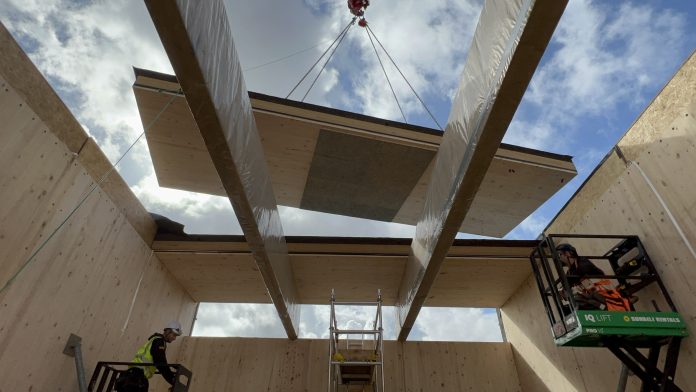As the Construction Innovation Hub wraps up its operations, programme director Keith Waller looks back on the impact of the Transforming Construction Challenge and urges government and industry to continue pushing for a better built environment
The Construction Innovation Hub began in 2018 with the Manufacturing Technology Centre (MTC), Building Research Establishment (BRE) and Centre for Digitally Built Britain (CDBB) embarking on a wide range of research activities as part of Innovate UK’s Transforming Construction Challenge.
We set ourselves some key challenges: how could we boost productivity, how could we embed digital ways of working, and how could we enable more manufactured solutions to deliver a better-built environment?
Research alone wouldn’t be enough to meet these challenges. We needed to do more than simply develop solutions – tools, processes, products – that aligned with the ambition of the Construction Sector Deal.
We also had to create the right environment for these solutions to thrive, working with clients, policymakers and regulators to ensure our innovation would have a home.
And we needed to bring industry with us.
Undertaking research in a vacuum might produce interesting outputs and valuable insight, but without capability, capacity and appetite in industry, any innovation would likely flounder.
We wanted to measure our success not by the activities we undertook but by the impact – focusing on delivering outcomes, not outputs.
We established the Construction Innovation Hub not as a market player but as a market enabler, including government and industry as key contributors to our programme.
Through this collaborative approach, we were able to help shape the policy environment, contributing to the Construction Playbook and Infrastructure & Projects Authority TIP Roadmap to 2030.
Hundreds of organisations worked with us on the development of our tools. Key industry players – consultants, contractors and manufacturers, both large and small – have helped co-develop solutions. Without their insight and input, our impact would be lessened.
How do we measure the impact of the Construction Innovation HUB?
Focusing on outcomes, not just outputs, has been key. Success from the four-and-a-half years and over £80m of funding is seeing the innovations adopted, and through their adoption, the ambitions of the Construction Sector Deal become more tangible.
The construction of the sandpit structures in 2022 at MTC was an important milestone. The sandpits are full-scale, physical testbeds showcasing what can be achieved through a manufactured approach.
We wanted to prove that it could be done, that it was worth doing, and leave a legacy resource to provide clients and industry with a safe space to test, optimise and de-risk new approaches.
This brings us to the last six months. Led by the MTC, the Construction Innovation Hub embarked on a six-month deployment sprint, working with BRE and industry partners to deploy solutions at pace and provide a safe space to test and learn.
Moving from R&D to deployment and adoption
This focus on deployment and adoption was critical to ensuring the Construction Innovation Hub’s outputs have a secure future and allowing people to witness practical results first-hand. It has resulted in a clear step-change in both understanding of the potential and an enthusiasm to push further.
“Learning by doing” is critical. It has been great to see the sandpits used by the government and industry to test solutions for education and healthcare and to develop solutions with standardisation and interoperability at the forefront.
For example, by developing a model for a single-patient room approach for our hospitals, we don’t just benefit the patients and clinicians, but we can also take the learnings and apply them to homes, schools or prisons.
Comparing traditional outputs and production rates with what has been achieved on the sandpits is enlightening. The speed of delivery is much faster. Quality is higher.
The demand for labour, transport, for waste skips is vastly reduced. The sandpits help prove the value of a manufacturing approach and have been instrumental in ensuring the transformation can continue.
And through a rich set of papers and analysis, we have also strengthened the Product Platform Rulebook by producing an economic analysis of the value of a platform approach to support deployment and real-life application. The scale of the potential benefits is staggering.
But even with all this progress, there is so much more that can be achieved. This momentum must continue in industry and government so the UK can build faster, safer and better.
The economic climate, cost of living crisis and climate challenges mean now, more than ever, we need to turn to innovation to develop solutions that allow us to improve productivity, reduce carbon, support better jobs and deliver value.
The funding may have ended, but the job is not finished
The collaborative spirit, the ambition we have seen over the past four-and-a-half years, must continue. The groundwork has been laid – not just by the Hub but by all the many contributors from across government and industry.
We must build on the impact of what the Transforming Construction Challenge has already delivered and go further, go faster. We must remain bold and keep our collective ambition.
I am so grateful to the whole Hub team and to those many, many organisations and individuals who have supported us throughout. Let’s keep it going.
Keith Waller
Programme director
Construction Innovation Hub
sandpits@the-mtc.org
www.constructioninnovationhub.org.uk
Twitter
LinkedIn
YouTube

















